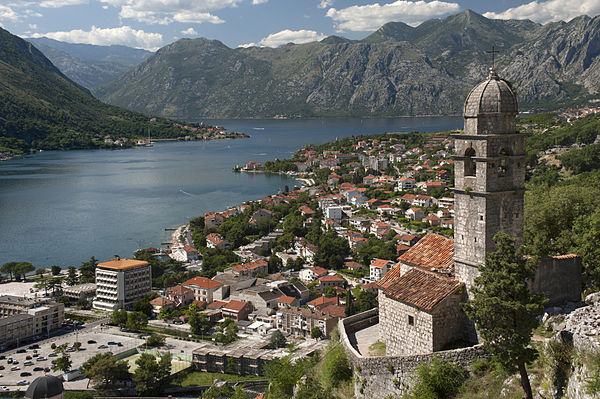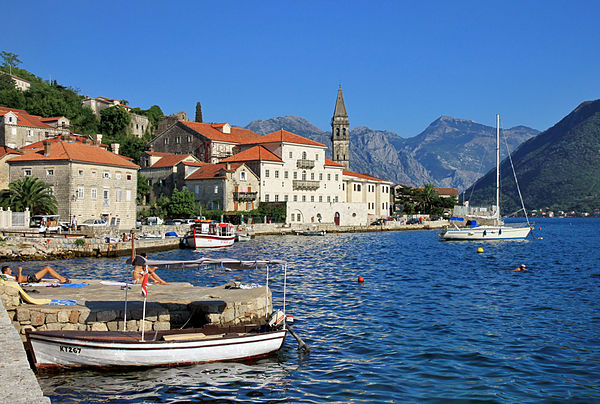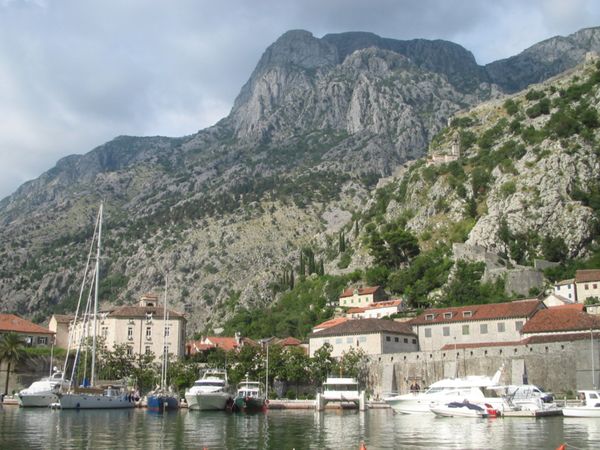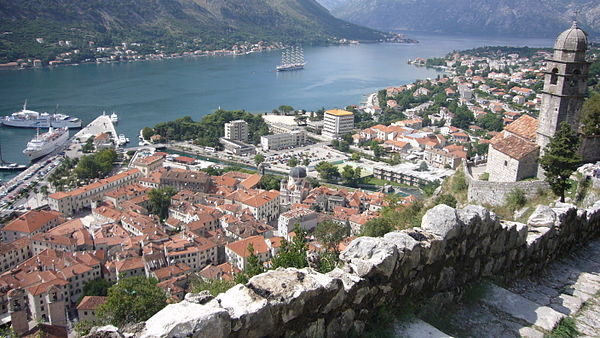Kotor is a coastal town in Montenegro with a population of about 13,500. It is well-known for its World heritage medieval structures (including churches and fortifications) and its stunning natural setting at the very edge of the mountain-rimmed Kotor Bay.


Kotor is situated in a most secluded tip of Boka Kotorska bay, in the northern part of the Montenegro coast on the Adriatic Sea. Kotor has developed around Stari Grad (local language for "old town"), the city's old town and best known landmark, which is listed with UNESCO World heritage sites. Kotor Bay is the deepest natural fjord-like bay in the Mediterranean Sea, and the scenery around it (including the steep mountains which come almost straight down to the waters edge) is spectacular.
Kotor is also unique because it is the only town on the eastern coast of the Adriatic Sea to be located by name in historic and strategic maps. Old Kotor was built like a maze for protective purposes and it is very easy to get lost here. In fact, even the locals get lost. Take a wrong turn and you will wind up far from your destination. This can happen even with a town map in hand. However, looking for landmarks, such as the 12th century St. Tryphon Cathedral, will help—and these landmarks are listed on nearly every tourist map.


The population of Kotor is multi-ethnic: less than half are Montenegrins, less than a third are Serbians, and a tenth are Croatians. Kotor is still the seat of the Catholic Bishopric of Kotor, which covers the entire area surrounding the gulf of Kotor.
- Old Town. The Old Town is the most famous part of Kotor, where the Kotor history, culture, and tradition are being preserved. The old town of Kotor has a great number of monuments of the medieval architecture: churches, cathedrals, palaces, and museums. They are complemented with the multitude of narrow streets, squares, and markets. The main and the biggest square is Trg od oruzja (Square of arms). That square was and remained the main place for gathering. In addition, there are some significant cultural monuments like: Tower watch (VIII century), Cathedral of Sveti Tripun (XIII century), Church of Sveti Luka (XIII century), Prince’s palace (XVII century), Church of Sveta Marija (XII century), Church of Our Lady of Health (Gospe od Zdravlja) (XV century), and Napoleon’s Theater (XIX century). Old Kotor has also numerous palaces like: Bizanti, Buca, Pima, and Grgurin (which houses the Maritime museum). The old town of Kotor today is considered to be the best preserved medieval urban entity in the Mediterranean. There are three entrances to the Old Town, the main one is the Sea Gate of 1555. Free.
- St Tryphon's Cathedral, (Old Town). First built in the 11th century, reconstructed after earthquakes. Romanesque-Gothic architecture. Chapel holds the remains of St. Tryphon, the patron saint of Kotor. €2.
- St Nicolas Church. The biggest Orthodox church in the Old Town.
- Maritime Museum, (Old Town), ☎ 304720. M-Sa: 8am-8pm; Sundays: 9am-1pm. The memories on those long gone sailing days and years, the successes of the famous Kotor seaman, artists, ship builders, crafts man, states man, and diplomats, intermediaries between west and east, are kept in the Maritime museum, which is housed in the baroque palace Grgurin. In the museum, one can find three floors of portraits of the famous captains, models of old galleys and sail boats, navigational instruments, photographs, uniforms, weapons, paintings, and model ships. €4.
- The Island Gospa od Skrpjela (Our Lady of the Rock). The Island Gospa od Skrpjela is one of two gorgeous islands in Kotor Bay, which are situated in the bay across from Perast (in the Kotor municipality). The other island, which also should be visited, is the Island Sveti Djordje (St. George). That island is also called "the island of the dead captains", because according to a legend one French soldier, by shooting from cannon towards Perast, hit a house of his beloved girl and killed her. That legend was a motive for the master piece "The Island of the Dead" by the Switzerland painter Beklin. The Island Gospa od Skrpjela is an artificial island, made by seaman from Perast and Kotor, who on their big sail boats brought in large boulders. According to stories, fisherman from Perast, after a shipwreck near the island, found an icon of the Holy Mother of God with the Christ on a sea rock, so they vowed to build a church on the island. They built the church in 1630. As the island had to be maintained, seaman continued to bring in stones, so that tradition is alive even today. It is called Fasinada from Perast (July 22).
Source: https://wikitravel.org/en/Kotor



